Maybe a nosler partition?If I could get consistent exits, I would keep using them. Unfortunately, I’m 100% at no exits on deer I’ve shot. My search continues for a better bullet for my 223.
Navigation
Install the app
How to install the app on iOS
Follow along with the video below to see how to install our site as a web app on your home screen.
Note: This feature may not be available in some browsers.
More options
Style variation
You are using an out of date browser. It may not display this or other websites correctly.
You should upgrade or use an alternative browser.
You should upgrade or use an alternative browser.
.223 for bear, mountain goat, deer, elk, and moose.
- Thread starter PNWGATOR
- Start date
Mojohand
FNG
- Joined
- Nov 9, 2023
- Messages
- 18
Long ass thread and very interesting with solid results. Haven't read through the whole thing but checked out many of the pics from the “cheat sheet”. Seems like a lot of 77 TMK results.
Any use the old 75 gr Amax? I still have a ton of those sitting around and have them loaded to 2900 fps out of my Tikkler. If I can get a draw, I'd love to be able to gun one through an elk or Muley. They shoot lights out so reluctant to go stock up on TMKs if they're both basically apples-to-apples.
Any use the old 75 gr Amax? I still have a ton of those sitting around and have them loaded to 2900 fps out of my Tikkler. If I can get a draw, I'd love to be able to gun one through an elk or Muley. They shoot lights out so reluctant to go stock up on TMKs if they're both basically apples-to-apples.
- Joined
- Feb 24, 2023
- Messages
- 2,686
If I could get consistent exits, I would keep using them. Unfortunately, I’m 100% at no exits on deer I’ve shot. My search continues for a better bullet for my 223.
What's your impact velocity been? I mean we have basically been point blank range but we have a 16" barrel.
wind gypsy
"DADDY"
- Joined
- Dec 30, 2014
- Messages
- 12,739
It’s not common sense. It’s a position taken in what people think would be the case because they’re missing many factors that come into play when it comes to terminal performance. The biggest bullet failures I’ve seen on game was a 300 RUM shooting 180 grain bullets. Bullet diameter is a minimal part of the equation for bullet performance. The two biggest factors are impact velocity and bullet construction. These need to be paired together to produce the desired results. The problem with this is we have 100% control over the bullet we choose so we get the construction we want. What we can’t completely control is impact velocity. Rarely, if ever will a hunter know the exact distance they will be shooting and thus we can’t control impact velocity as it’s dependent on shot distance. From what I’ve seen from following this whole thread is the 77 TMK has a broad impact velocity range where it has been proven to perform great on game from a 223. I have my doubts on its ability to perform the same at close ranges if it’s used in a 22 creedmore or a 220 swift at much higher velocities. The point is that this combination has been proven to be effective on game when used within its impact velocity window. Every combination in every caliber has an optimum velocity window so larger calibers also have these limitations. On the edges of these velocity windows the combinations can still produce the desired results but if we stray too far we can have complete bullet failures and lost game which is what happened with the 300 RUM example I referenced earlier. So to answer your question of what’s the point? The point is this is a proven combination, it’s effective. What else should we be looking for when trying to take game? Many people are choosing this combination for just that reason. I’ve never even fired a TMK but after seeing the results here I’m considering using it, while not in a 223 or 5.56 but in another smaller caliber at approximately the same muzzle velocity. I have tons of other options of larger calibers but I’m considering this combination for Wisconsin whitetails purely from a performance standpoint. I have nothing to prove by using a “smaller” caliber. I’m considering this because of the examples shown in this thread make me believe it’ll serve my purposes perfectly from zero yards out to the maximum range I’d ever expect to be shooting a deer and that’s something that has been a struggle with many of the larger calibers. Sure they’ll perform well at a distance where impact velocity is slower but finding a bullet that’ll perform from zero to max shot distance is not always an easy task.
Sent from my iPhone using Tapatalk
The post you quoted was from 5 years ago by a guy that I think has been banned for a while now.
Bubbadoyle
Lil-Rokslider
- Joined
- Nov 6, 2022
- Messages
- 136
The post you quoted was from 5 years ago by a guy that I think has been banned for a while now.
Yeah, somehow I ended up at the top of the thread and thought I was somewhat current.
Sent from my iPhone using Tapatalk
- Joined
- Feb 12, 2021
- Messages
- 1,466
Genuine question- why does exit matter to you?If I could get consistent exits, I would keep using them. Unfortunately, I’m 100% at no exits on deer I’ve shot. My search continues for a better bullet for my 223.
Because I can’t find it if it doesn’t bleed. Two holes have always given me better blood trails.Genuine question- why does exit matter to you?
I’m gonna give 70 grain Accubonds a try this season. I’m just waiting on the season to open.Maybe a nosler partition?
Don’t know. I haven’t shot anything with that bullet over 150 yards. I’m 2800 fps at the muzzle.What's your impact velocity been? I mean we have basically been point blank range but we have a 16" barrel.
primarchtimmy
FNG
- Joined
- Apr 24, 2024
- Messages
- 12
They're killers. I have them to swap too if I ever run out of 77tmkLong ass thread and very interesting with solid results. Haven't read through the whole thing but checked out many of the pics from the “cheat sheet”. Seems like a lot of 77 TMK results.
Any use the old 75 gr Amax? I still have a ton of those sitting around and have them loaded to 2900 fps out of my Tikkler. If I can get a draw, I'd love to be able to gun one through an elk or Muley. They shoot lights out so reluctant to go stock up on TMKs if they're both basically apples-to-apples.
- Joined
- Jul 18, 2023
- Messages
- 1,321
Aha!Saw the impact at the shot, he hopped and then started staggering right away, I was tracking him in the scope waiting for him to stop (he was coming my way) and as soon as he stopped I was pressing the trigger and he fell as the trigger broke and I grazed his back on that shot
Finally, a miss !!!
On Saturday I got up at 5am, burned some toast, had a coffee, and climbed a hill. Spotted a chamois from the ridge top and dropped down to have a closer look. Nanny and kid, leave them alone. Had a good hard look at a patch of scrub and eventually located a hind bedded, visible through a small gap in the vegetables. Got a good position with my schedium on top of a tripod and shot her.

80gr ELDM, 330m, impact V about 2200fps. Shot was 27⁰ downhill angle, quartering to. She ran 10 metres downhill and died. Bullet entered high shoulder, shattered the scapula, broke a rib, went through 1 lung and the heart, and ended up in the gut cavity. She still ran despite the broken bone, it is my observation that breaking front legs doesn't do a lot to stop them running, and heart shots often run.
Knife pointing to entry
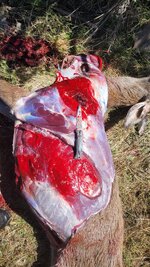
Wound on the inside of the shoulder
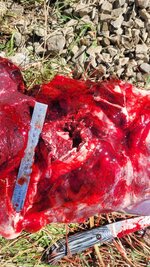
And correspondingly on the ribs
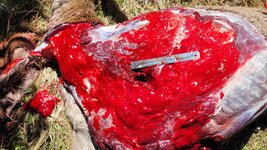
Lung wound channel. I gave them a rinse in the creek. Big permanent wound cavity and a large zone of extravasation.
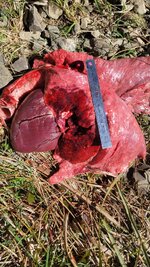
Heart
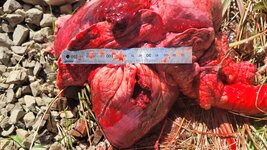
Inside rib cage

Bullet jacket & core as found


80gr ELDM, 330m, impact V about 2200fps. Shot was 27⁰ downhill angle, quartering to. She ran 10 metres downhill and died. Bullet entered high shoulder, shattered the scapula, broke a rib, went through 1 lung and the heart, and ended up in the gut cavity. She still ran despite the broken bone, it is my observation that breaking front legs doesn't do a lot to stop them running, and heart shots often run.
Knife pointing to entry

Wound on the inside of the shoulder

And correspondingly on the ribs

Lung wound channel. I gave them a rinse in the creek. Big permanent wound cavity and a large zone of extravasation.

Heart

Inside rib cage

Bullet jacket & core as found

- Joined
- Oct 22, 2014
- Messages
- 13,525
I have my doubts on its ability to perform the same at close ranges if it’s used in a 22 creedmore or a 220 swift at much higher velocities.
Keep reading the thread(s) there are a bunch of TMK kills above 3,200fps impact. It is beyond too much damage for food at that speed.
Bubbadoyle
Lil-Rokslider
- Joined
- Nov 6, 2022
- Messages
- 136
Keep reading the thread(s) there are a bunch of TMK kills above 3,200fps impact. It is beyond too much damage for food at that speed.
I’m sure there are. I’m sure it can work but I was trying to imply that consistent results will likely not be the case. I’ve seen a 180 grain sst fail at 150 yards on a broadside whitetail two times. Because of this I won’t ever use lightly constructed bullets at higher velocities. From reading this thread I’ve come to believe that 223 velocities seem to pair almost perfectly with the 77 TMK.
Sent from my iPhone using Tapatalk
- Joined
- Feb 24, 2023
- Messages
- 2,686
Congratulations to the boy.
What’s your velocity with that load? Thanks.
2611fps from my notes.
- Joined
- Oct 22, 2014
- Messages
- 13,525
I’m sure there are. I’m sure it can work but I was trying to imply that consistent results will likely not be the case. I’ve seen a 180 grain sst fail at 150 yards on a broadside whitetail two times. Because of this I won’t ever use lightly constructed bullets at higher velocities. From reading this thread I’ve come to believe that 223 velocities seem to pair almost perfectly with the 77 TMK.
Sent from my iPhone using Tapatalk
The 77gr TMK not “lightly constructed” and it works spectacularly at least to 3,400fps impact on deer.
Bubbadoyle
Lil-Rokslider
- Joined
- Nov 6, 2022
- Messages
- 136
The 77gr TMK not “lightly constructed” and it works spectacularly at least to 3,400fps impact on deer.
I have zero experience with them so it was just an assumption from my experience with many other bullets. If that’s truly the case, which I tend to believe it is as I have zero reason to doubt you then it seems to be about a perfect bullet.
Sent from my iPhone using Tapatalk
I'm thinking 75 grain Gold Dots might exit more reliably, but haven't seen any of them for sale (for reloading). I'll give them a try at some point.If I could get consistent exits, I would keep using them. Unfortunately, I’m 100% at no exits on deer I’ve shot. My search continues for a better bullet for my 223.
I suppose a 62 TSX would as well, but the Gold Dot might do a little better terminally? So many things to try out!
So far though, 77TMKs and 73ELD-M have been pretty good at not requiring any tracking...but when it does happen, yes, an exit is probably helpful.
Similar threads
- Replies
- 35
- Views
- 3K
- Replies
- 98
- Views
- 6K
- Replies
- 4
- Views
- 286
Featured Video
Latest Articles
- TT#64 Josh Boyd Elk Hunting Strategies for Every Season
- Aaron Davidson of Gunwerks
- TT#63 Dirk Durham’s Art of Elk Calling
- BIG Buck Stories with the Dirty Giants Podcast
- TT#62 Brian Barney Hunting Bulls without Calling
- Hoyt Alpha AX-2 SD Review
- Kuiu Kenai vs Outdoor Vitals Vario Hooded Jacket Review
- Hoyt RX-9 Ultra Review
- Hunting Vampire Bucks & Building an Optics Kit
- Darton Sequel ST2 35 Review


